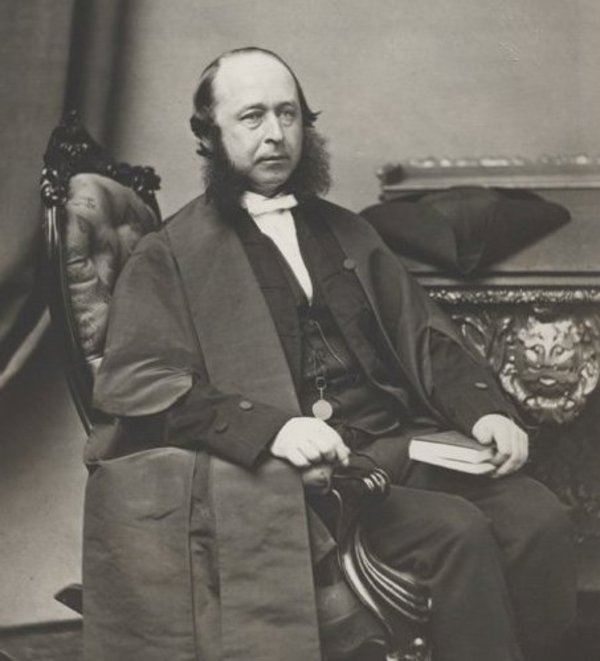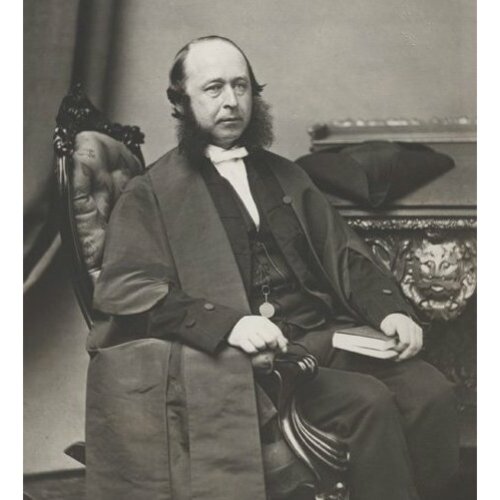
Source: Courtesy of Wikimedia Commons
TESSIER, ULRIC-JOSEPH (baptized Joseph-Ulric), author, lawyer, politician, professor, businessman, seigneur, and judge; b. 3 May 1817 at Quebec, son of Michel Tessier, a merchant, and Mariane Perrault, the widow of Jean Naud; m. 4 Aug. 1847 Marguerite-Adèle Kelly, granddaughter of the late Joseph Drapeau*, in Rimouski, Lower Canada, and they had eight children; d. 7 April 1892 at Quebec, and was buried 11 April in Belmont Cemetery, Sainte-Foy.
Ulric-Joseph Tessier was a descendant of a family from La Rochelle in France that settled in New France in 1709. He did his classical studies at the Petit Séminaire de Québec from 1826 to 1835 and in 1836 he became an articled clerk in the law office of Hector-Simon Huot*. On 1 and 3 May 1837 he published a romantic tale in the Quebec paper Le Télégraphe, entitled “Emma ou l’amour malheureux.” Drawing his inspiration from the cholera epidemic which had terrified the city in 1832, he wove a story around the themes of sudden death and impossible love.
Tessier was called to the Quebec bar on 22 June 1839, at the age of 22. Little is known of his activities or concerns at this stage of his career. Like other young men of his generation, he may have felt the nationalistic influence of Étienne Parent*, Augustin-Norbert Morin*, and Napoléon Aubin*. He burst onto the municipal political scene on 9 Feb. 1846, when he was elected alderman for Saint-Jean ward. He served regularly on various committees, particularly those dealing with fire, finances, and by-laws, and took a growing interest in public affairs. In 1847 he became the recording secretary of the local Société Saint-Jean-Baptiste. His marriage to Marguerite-Adèle Kelly, co-heiress of the seigneury of Rimouski, in August of that year heralded a promising future.
In December 1851 Tessier ran as a reform candidate in Portneuf. Elected to the Legislative Assembly of the Province of Canada, which then sat at Quebec, he readily showed his independence vis-à-vis the government. In particular he opposed its move to guarantee the loans required for improving the port of Montreal and he criticized the poorly organized sessions of the lawcourts.
Tessier also became involved in the development of the region around Quebec. He was one of the incorporators of the North Shore Railway Company in 1853. As mayor of Quebec from 14 Feb. 1853 to 13 Feb. 1854, he was anxious to maintain the city’s credit, which was being undermined by heavy debts; he therefore confined himself to continuing the laying of water mains, installation of sewer pipes, paving of streets, and widening of Rue de la Montagne (Côte de la Montagne), which had all been begun by his predecessors. With his terms as mayor and member of the legislature behind him, Tessier oversaw the publication in 1854 of his study Essai sur le commerce et l’ industrie du Bas-Canada. In 1855 he accepted a lectureship at the Université Laval, which was setting up its law faculty. He received a doctorate of laws from Laval that year, and in 1856 he was given the chair in civil procedure. The following year he agreed to go to London with the mayor of Quebec, Joseph Morrin*, to present Quebec’s claim to be the permanent capital of Canada. Queen Victoria chose Ottawa instead [see Sir George-Étienne Cartier*].
In December 1858 Tessier helped found the National Bank [see François Vézina*], of which he served as president or director for 20 years. In the autumn of 1858 he had returned to politics, being elected legislative councillor for Gulf division, a region where his wife had sizeable property holdings. During his campaign he advocated a moderate liberalism and thus he was appointed in May 1862 commissioner of public works and government leader in the Legislative Council for the ministry of John Sandfield Macdonald* and Louis-Victor Sicotte*. In 1862 he also participated in the conference that brought delegates to Quebec from the Province of Canada, New Brunswick, and Nova Scotia to discuss the construction of the Intercolonial Railway, a project which was enthusiastically supported by Quebec businessmen and for which Canada then agreed to pay seven-twelfths of the cost. Unable to reconcile regional differences, the Macdonald–Sicotte cabinet fell on 8 May 1863, depriving Tessier of the chance to show his real abilities. Once more just a member of the Legislative Council, he was chosen by his colleagues to be its speaker on 13 August and retained this office until 1 July 1867.
The constitutional change with confederation had little effect on Tessier’s career. On 22 May 1867 he had been named to the Senate to represent Gulf division. He apparently accepted the appointment for the prestige it conferred, rather than from inclination. He found life in Ottawa boring and stayed there only when parliament was in session. His interests lay elsewhere, first and foremost at Quebec, where he taught in the Université Laval and practised law with Tessier, Hamel et Tessier, and then at Rimouski, where his wife, upon the death of her mother on 27 Sept. 1869, inherited the seigneury of Rimouski. He steadily added to the couple’s real estate holdings, acquiring the seigneuries of Le Bic, Saint-Fabien, Saint-Simon, Saint-Mathieu, and Trois-Pistoles, and, lastly, part of the seigneury of Île-d’Orléans.
On 11 Feb. 1873 Tessier was appointed to the Superior Court of the district of Quebec and thus had to resign from the Senate. He had already entrusted the administration of his seigneuries to his son Ulric in 1871. On 8 Oct. 1875 he was appointed to the Court of Queen’s Bench. That month he went to Rome to negotiate a new papal charter for the Université Laval Thereafter most of his energies were devoted to his duties as a judge and to teaching law. He did, however, remain a director of the Caisse d’Économie de Notre-Dame de Québec [see François Vézina] for the rest of his life.
In September 1891 ill health forced Ulric-Joseph Tessier to resign from the bench. When he died the following year he left an estate valued at $347,446, consisting of bonds, shares in financial and mercantile companies, bank deposits, lands, and buildings. He had been one of the last of the generation who after the rebellions of 1837–38 had worked together, no doubt under the influence of Étienne Parent, to create a group of financial institutions enabling Quebec francophones to take their place in the economic life of the city and of the country.
Ulric-Joseph Tessier is the author of “Emma ou l’amour malheureux; épisode du choléra à Québec en 1832,” a story which appeared in Le Télégraphe (Québec) on 1 and 3 May 1837 and which has been reprinted in a number of places, including Le repertoire ou recueil de littérature canadienne, James Huston, compil. (4v., Montréal, 1848–50), 2: 17–30. He also wrote Essai sur le commerce et l’ industrie du Bas-Canada (Québec, 1854), and his “Rapport annuel du maire aux membres du conseil de ville de Québec” appears in Rapport annuel du trésorier de la cité de Québec pour l’année 1853 (Québec, [1854]), 1–4.
AC, Québec, État civil, Catholiques, Notre-Dame de Québec, 11 avril 1892. ANQ-BSLG, CE1-6, 4 août 1847; P-1. ANQ-Q, CE1-1, 4 mai 1817. Arch. de l’univ. Laval, Québec, 503/31/1. ASQ, Fichier des anciens. Can., Prov. of, Statutes, 1853, c.100. Debates of the Legislative Assembly of United Canada (Abbott Gibbs et al.), vol.11. Recensement de la ville de Québec en 1818 par le curé Joseph Signay, Honorius Provost, édit. (Québec, 1976). Le Canadien, 8 avril 1892. Le Courrier du Canada, 7 avril 1892. L’Événement, 8 avril 1892. Le Journal de Québec, 28 avril 1860. Canadian directory of parl. (Johnson). J. Desjardins, Guide parl. DOLQ, vol. 1. Geneviève Guimont Bastien et al., Inventaire des marchés de construction des archives civiles de Québec, 1800–1870 (3v., Ottawa, 1975), 3. Political appointments, 1841–65 (J.-O. Coté; 1866). Political appointments and judicial bench (N.-O. Coté). Quebec almanac, 1836. Quebec directory, 1847–77. P.-G. Roy, Les juges de la prov. de Québec. Turcotte, Le Conseil législatif. Univ. Laval, Annuaire (Québec), 1856–92. Wallace, Macmillan dict. Georges Bellerive, Délégués canadiens-français en Angleterre, de 1763 à 1867 . . . (Québec, [ 1913]). L.-M. Côté et al., Les maires de la vieille capitale. Antoine Gagnon, Monographie de Matane ([Rimouski, Qué.], 1945). Historique de la Banque d’économie de Québec (the Quebec Savings Bank), 1848–1948 (Québec, 1948). Mosaïque rimouskoise; une histoire de Rimouski, sous la dir. de M.-A. Caron et al. (Rimouski, 1979). Raymond Rioux et Cyr Michaud, Les cent ans de St-Ulric, de Tessierville à nos jours, 1869–1969 (Mont-Joli, Qué., 1969). François Vézina, Récit historique de la progression financière de la Caisse d’économie de Notre-Dame de Québec (Québec, 1878). “Un passé remarquable, un avenir prometteur: portrait de famille de la Banque nationale,” La Presse, 25 mai 1985, cahier spécial: 2–3.
Cite This Article
Michèle Brassard and Jean Hamelin, “TESSIER, ULRIC-JOSEPH (baptized Joseph-Ulric),” in Dictionary of Canadian Biography, vol. 12, University of Toronto/Université Laval, 2003–, accessed April 7, 2025, https://www.biographi.ca/en/bio/tessier_ulric_joseph_12E.html.
The citation above shows the format for footnotes and endnotes according to the Chicago manual of style (16th edition). Information to be used in other citation formats:
| Permalink: | https://www.biographi.ca/en/bio/tessier_ulric_joseph_12E.html |
| Author of Article: | Michèle Brassard and Jean Hamelin |
| Title of Article: | TESSIER, ULRIC-JOSEPH (baptized Joseph-Ulric) |
| Publication Name: | Dictionary of Canadian Biography, vol. 12 |
| Publisher: | University of Toronto/Université Laval |
| Year of revision: | 1990 |
| Access Date: | April 7, 2025 |



